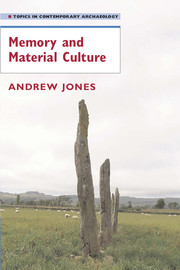Book contents
- Frontmatter
- Contents
- Preface
- 1 Memory and Material Culture?
- 2 From Memory to Commemoration
- 3 People, Time, and Remembrance
- 4 Improvising Culture
- 5 Continuous Houses, Perpetual Places: Commemoration and the Lives of Neolithic Houses
- 6 Culture, Citation, and Categorisation: Regionality in Late Neolithic Britain and Ireland
- 7 Chains of Memory: The Aesthetics of Memory in Bronze Age Britain
- 8 The Art of Memory: Memory, Inscription, and Place
- 9 Tracing the Past: Landscape, Lines, and Places
- 10 Coda
- References
- Index
3 - People, Time, and Remembrance
Published online by Cambridge University Press: 07 December 2009
- Frontmatter
- Contents
- Preface
- 1 Memory and Material Culture?
- 2 From Memory to Commemoration
- 3 People, Time, and Remembrance
- 4 Improvising Culture
- 5 Continuous Houses, Perpetual Places: Commemoration and the Lives of Neolithic Houses
- 6 Culture, Citation, and Categorisation: Regionality in Late Neolithic Britain and Ireland
- 7 Chains of Memory: The Aesthetics of Memory in Bronze Age Britain
- 8 The Art of Memory: Memory, Inscription, and Place
- 9 Tracing the Past: Landscape, Lines, and Places
- 10 Coda
- References
- Index
Summary
How do people and societies situate themselves in time? One way in which time is stabilised and measured is through the use of material culture. In what way are artefacts used as mnemonic devices to present and measure temporal spans? The way in which the material world is drawn upon as a means of situating a person or a society in time is complex and multilayered. To explore these ideas, this chapter begins by looking at an example of the relationship between memory and material culture from Mesoamerica.
People inhabiting the Classic Maya world of Mesoamerica between 500 and 1000 AD would have lived in ordered spaces replete with signs of social commemoration. Freestanding sculptures, such as stelae and altars, surrounded monumental plazas. The walls, lintels, and stairs of these monumental buildings were carved with inscriptions and friezes. Inscriptions of this kind were used to convey the biography or history of the elite. As Joyce (2003, 105) puts it: ‘their primary message is one of remembering a monumental past and linking it to the future’. Because the carved image of a persons head or face on standing stones or stelae was perceived to be a literal embodiment of the essence of that person (their Bah), the provision of carved and inscribed stelae was also a device for physically presencing absent elites. Through representation Classic Maya rulers were able to perform the extraordinary trick of being in two places at once, thereby transcending space and time (Houston and Stuart; 1998, 90).
- Type
- Chapter
- Information
- Memory and Material Culture , pp. 47 - 69Publisher: Cambridge University PressPrint publication year: 2007

